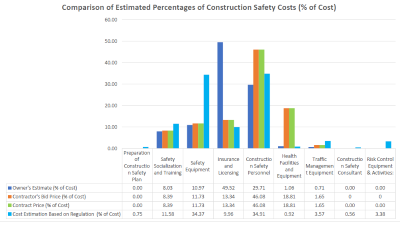Cost Analysis of Construction Safety Management Systems: Compliance Assessment with Indonesian Safety Regulations
DOI:
https://doi.org/10.24036/cived.v12i1.739Keywords:
Construction Safety, Regulatory Compliance, Safety Management, Risk Prevention, Budget AllocationAbstract
The Indonesian construction sector plays a vital role in national economic development, yet it continues to face significant occupational safety challenges. This study assesses the implementation of Construction Safety Management Systems by national safety regulations, with a focus on compliance within the XYZ construction project. Using a mixed-methods approach, the research combines quantitative budget analysis with qualitative field observations and interviews with safety officers. Findings indicate that while safety measures were implemented, budget allocations remained insufficient to meet regulatory requirements. Critical components, such as safety training and preventive risk control measures, were notably underfunded, reflecting gaps between policy mandates and their practical execution. The study highlights systemic challenges in safety budget planning, including inconsistent incorporation of regulatory standards and disproportionate allocation across safety components. These findings contribute to broader discussions on construction safety governance in emerging economies, emphasizing the need for improved compliance mechanisms and accountability frameworks. Practical recommendations include the adoption of risk-based budgeting approaches and enhanced oversight to ensure adequate safety investments. The research provides valuable insights for policymakers and industry stakeholders seeking to strengthen safety management practices in public construction projects.
Downloads
References
N. F. Ali and M. A. Mansor, “Specify the Priorities of Indicators for Measuring the Performance Success of Construction Projects,” Tikrit Journal of Engineering Sciences, vol. 29, no. 1, pp. 36–45, 2022, doi: 10.25130/tjes.29.1.4.
M. Luo, B. G. Hwang, X. Deng, N. Zhang, and T. Chang, “Major Barriers and Best Solutions to the Adoption of Ethics and Compliance Program in Chinese International Construction Companies: A Sustainable Development Perspective,” Buildings, vol. 12, no. 3, Mar. 2022, doi: 10.3390/buildings12030285.
M. O. Sanni-Anibire, A. S. Mahmoud, M. A. Hassanain, and B. A. Salami, “A risk assessment approach for enhancing construction safety performance,” Saf Sci, vol. 121, pp. 15–29, 2020, [Online]. Available: http://dx.doi.org/10.1016/j.ssci.2019.08.044
A. Munang and I. Nurisusilawati, “Modeling Underlying Pattern Making Construction Safety Risk Mitigation Decisions Using Dynamic Systems,” Jurnal Ilmiah Teknik Industri, vol. 21, no. 1, pp. 37–48, Jun. 2022, doi: 10.23917/jiti.v21i1.17429.
A. Kadir et al., “Safety Climate in the Indonesian Construction Industry: Strengths, Weaknesses and Influential Demographic Characteristics,” Buildings, vol. 12, no. 5, May 2022, doi: 10.3390/buildings12050639.
A. Othman I. and Azman, “Safety Misbehaviour and Its Effect Towards Safety Performance of Construction Projects,” in ICACE 2019, M. R. Awang Mokhtar and Meor M Fared, Ed., Singapore: Springer Singapore, 2020, pp. 193–200.
K. Manik, O. N. Putri, S. F. Azzahra, M. Anda, Juliastuti, and Y. Wijayanti, “Sustainability in Construction Work: A Perspective on Accidents and Building Failure Mitigation in Indonesia,” in IOP Conference Series: Earth and Environmental Science, IOP Publishing Ltd, Aug. 2021. doi: 10.1088/1755-1315/794/1/012065.
F. Lestari, R. Y. Sunindijo, M. Loosemore, Y. Kusminanti, and B. Widanarko, “A safety climate framework for improving health and safety in the Indonesian construction industry,” Int J Environ Res Public Health, vol. 17, no. 20, pp. 1–20, Oct. 2020, doi: 10.3390/ijerph17207462.
A. Syaiful, R. Arifin, A. Suraji, and D. B. Istijono, “Pengukuran Tingkat Penerapan Norma, Standar, Prosedur Dan Kriteria Keselamatan Dan Kesehatan Kerja (Nspk K3) Pada Proyek Konstruksi,” 2014.
A. Tezel, E. Dobrucali, S. Demirkesen, and I. A. Kiral, “Critical success factors for safety training in the construction industry,” Buildings, vol. 11, no. 4, Apr. 2021, doi: 10.3390/buildings11040139.
H. Chen, Y. Mao, Y. Xu, and R. Wang, “The Impact of Wearable Devices on the Construction Safety of Building Workers: A Systematic Review,” Jul. 01, 2023, Multidisciplinary Digital Publishing Institute (MDPI). doi: 10.3390/su151411165.
L. Albert and C. Routh, “Designing impactful construction safety training interventions,” Jun. 01, 2021, MDPI AG. doi: 10.3390/safety7020042.
O. Giri, “Factors Causing Health and Safety Hazards at Construction Sites,” Technical Journal, vol. 2, pp. 68–74, Nov. 2020, doi: 10.3126/tj.v2i1.32841.
A. Onazi, Application of Dynamic Risk Approach to Mitigate Major Accidents. 2021. doi: 10.2118/206273-MS.
P.-É. Boileau, “Sustainability and prevention in occupational health and safety,” Ind Health, vol. 54, pp. 293–295, Jul. 2016, doi: 10.2486/indhealth.54-293.
O. Hadi, “Analyzing Explicit and Implicit accidents workplace costs: .,” International Journal of Scientific Research and Management, vol. 10, pp. 3530–3539, May 2022, doi: 10.18535/ijsrm/v10i5.em08.
T. Chen and Z. Cao, “Construction safety: an analysis of the cross-influence of economic, construction, and accident death factors,” Environmental Science and Pollution Research, vol. 28, pp. 1–12, Dec. 2021, doi: 10.1007/s11356-021-15231-4.
N. Ishak, M. Mansor, A. Ahmad, A. Jaafar, and N. Jaffar, “Hindrance in Safety Management Practices in The Construction of Infrastructure Projects,” International Journal of Academic Research in Business and Social Sciences, vol. 12, Aug. 2022, doi: 10.6007/IJARBSS/v12-i8/14491.
W. Darul and R. A. Saraswati2, “Analisis Implementasi Sistem Manajemen Keselamatan Konstruksi (SMKK) (Studi Kasus Pembangunan Gedung Kantor Pengadilan Negeri Sungguminasa Kelas 1a ),” Journal on Education, vol. 05, no. 03, pp. 7528–7538, 2023.
I. Sutapa, I. Suasira, P. Hermawati, and I. Dharma, “Analisis Tingkat Risiko Dan Penerapan Smk3 Pada Proyek Pembangunan Rumah Sakit Umum Daerah Mangusada Badung,” Jurnal Ilmiah Poli Rekayasa, vol. 17, p. 25, Feb. 2022, doi: 10.30630/jipr.17.1.213.
S. Jung and S. Kim, “A study on the scope of the safety and health management system at construction sites to respond to the Severe Disaster Punishment Act,” Forum of Public Safety and Culture, vol. 16, pp. 173–187, May 2022, doi: 10.52902/kjsc.2022.16.173.
F. Salguero-Caparrós, E. Sánchez-Teba, and G. Bermudez-Gonzalez, “Where is occupational health and safety management research in small and medium-sized enterprises headed? A thematic evolution and bibliometric analysis,” Cogent Business & Management, vol. 12, Mar. 2025, doi: 10.1080/23311975.2025.2482021.

Downloads
Published
How to Cite
Issue
Section
License
Copyright (c) 2025 Ari Syaiful Rahman Arifin, Faisal Ashar, Fitra Rifwan, Nevy Sandra

This work is licensed under a Creative Commons Attribution 4.0 International License.







2.jpg)
